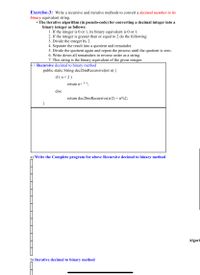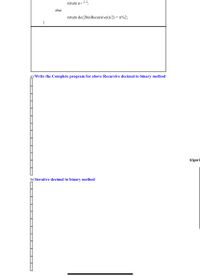
Computer Networking: A Top-Down Approach (7th Edition)
7th Edition
ISBN: 9780133594140
Author: James Kurose, Keith Ross
Publisher: PEARSON
expand_more
expand_more
format_list_bulleted
Question

Transcribed Image Text:Exercise-3: Write a recursive and iterative methods to convert a decimal number to its
binary equivalent string.
The iterative algorithm (in pseudo-code) for converting a decimal integer into a
binary integer as follows:
1. If the integer is 0 or 1, its binary equivalent is 0 or 1.
2. If the integer is greater than or equal to 2 do the following:
3. Divide the integer by 2.
4. Separate the result into a quotient and remainder.
5. Divide the quotient again and repeat the process until the quotient is zero.
6. Write down all remainders in reverse order as a string.
7. This string is the binary equivalent of the given integer.
// Recursive decimal to binary method
public static String dec2binRecursive(int n) {
if (n<2)
return n+ " ".
else
return dec2binRecursive(n/2) + n%2;
}
a) Write the Complete program for above Recursive decimal to binary method
Algorit
b) Iterative decimal to binary method

Transcribed Image Text:II II.
return n+ " ";
else
return dec2binRecursive(n/2) + n%2;
}
a) Write the Complete program for above Recursive decimal to binary method
Algorin
b) Iterative decimal to binary method
Expert Solution
This question has been solved!
Explore an expertly crafted, step-by-step solution for a thorough understanding of key concepts.
Step by stepSolved in 2 steps with 2 images

Knowledge Booster
Similar questions
- 8arrow_forwardEx. 01 : Recursion About So far, we have learned that we can perform repetitive tasks using loops. However, another way is by creating methods that call themselves. This programming technique is called recursion and, a method that calls itself within it's own body is called a recursive method. One use of recursion is to perform repetitive tasks instead of using loops, since some problems seem to be solved more naturally with recursion than with loops. To solve a problem using recursion, it is broken down into sub-problems. Each sub-problem is similar to the original problem, but smaller in size. You can apply the same approach to each sub-problem to solve it recursively. All recursive methods use conditional tests to either 1. stop or 2. continue the recursion. Each recursive method has the following characteristics: 1. end/terminating case: One or more end cases to stop the recursion. 2. recursive case: reduces the problem in to smaller sub-problems, until it reaches (becomes) the end…arrow_forwardC++arrow_forward
- 6) Write a recursive function to calculate the summation of numbers from 1 to n. For exampleif the user enters 5, your program would add 1+2+3+4+5 and print out the answer 15.7) Write a recursive program to calculate Fibonacci numbers. Use the definition of a Fibonaccinumber where F(n) = F(n-1) + F(n-2). use java to codearrow_forwardAssignment-2-162-sumer 22.000X 5.0 KB) ZOOM 5. Palindrome Detector A palindrome is any word, phrase, or sentence that reads the same forward and backward. Here are some well-known palindromes: Able was I, ere I saw Elba A man, a plan, a canal, Panama Desserts, I stressed Kayak Write a boolean method that uses recursion to determine whether a string argument is a palindrome. The method should return true if the argument reads the same forward and backward. Demonstrate the method in a program.arrow_forwardPython Using recursion only No loops Note that in a correct solution the isdigit method or in operator will never be applied to the entire string s. The function must return and not print the resulting string. def getDigits(s):arrow_forward
- write a code in java (using recursion)arrow_forwardMake a code using Recursion The countSubstring function will take two strings as parameters and will return an integer that is the count of how many times the substring (the second parameter) appears in the first string without overlapping with itself. This method will be case insensitive. For example: countSubstring(“catwoman loves cats”, “cat”) would return 2 countSubstring(“aaa nice”, “aa”) would return 1 because “aa” only appears once without overlapping itself. public static int countSubstring(String s, String x) { if (s.length() == 0 || x.length() == 0) return 1; if (s.length() == 1 || x.length() == 1){ if (s.substring(0,1).equals(x.substring(0,1))){ s.replaceFirst((x), " "); return 1 + countSubstring(s.substring(1), x); } else { return 0 + countSubstring(s.substring(1), x); } } return countSubstring(s.substring(0,1), x) + countSubstring(s.substring(1), x); } public class Main { public static void main(String[] args) {…arrow_forwardCS211 Non-recursive solution for Towers of Hanoi Using the algorithm discussed in class, write an iterative program to solve the Towers of Hanoi problem. The problem: You are given three towers a, b, and c. We start with n rings on tower a and we need to transfer them to tower b subject to the following restrictions: 1. We can only move one ring at a time, and 2. We may never put a larger numbered ring on top of a smaller numbered one. There are always 3 towers. Your program will prompt the user for the number of rings. Here is the algorithm. Definition: A ring is "available" if it is on the top of one of the towers. Definition: The "candidate" is the smallest available ring that has not been moved on the most recent move. The first candidate is ring 1. The Algorithm: 1. Find the candidate. 2. Move the candidate (right or left, depending if the number of rings is odd or even) to the closest tower on which it can be placed. Move "around the circle" if necessary. 3. If not done, go back…arrow_forward
- Complete the following program Multiply.java. This program uses recursion to multiply two numbers through repeated addition. The output should look exactly like what is pictured below. The code should be completed where it states "complete here"arrow_forwardPart (1) Write a recursion method named CalculateSeries, that will receive one integer valuen as parameter. The method will calculate and return the term n in the following series: T(0)= 0 T(n)= 2 T(n-1) +1 Part (2) Write the main method to test your method. Enter n >> 5 T(5) = 31 %3Darrow_forwardT/F 11. A recursion will still be replaced by an iteration and the other way around.arrow_forward
arrow_back_ios
SEE MORE QUESTIONS
arrow_forward_ios
Recommended textbooks for you
 Computer Networking: A Top-Down Approach (7th Edi...Computer EngineeringISBN:9780133594140Author:James Kurose, Keith RossPublisher:PEARSON
Computer Networking: A Top-Down Approach (7th Edi...Computer EngineeringISBN:9780133594140Author:James Kurose, Keith RossPublisher:PEARSON Computer Organization and Design MIPS Edition, Fi...Computer EngineeringISBN:9780124077263Author:David A. Patterson, John L. HennessyPublisher:Elsevier Science
Computer Organization and Design MIPS Edition, Fi...Computer EngineeringISBN:9780124077263Author:David A. Patterson, John L. HennessyPublisher:Elsevier Science Network+ Guide to Networks (MindTap Course List)Computer EngineeringISBN:9781337569330Author:Jill West, Tamara Dean, Jean AndrewsPublisher:Cengage Learning
Network+ Guide to Networks (MindTap Course List)Computer EngineeringISBN:9781337569330Author:Jill West, Tamara Dean, Jean AndrewsPublisher:Cengage Learning Concepts of Database ManagementComputer EngineeringISBN:9781337093422Author:Joy L. Starks, Philip J. Pratt, Mary Z. LastPublisher:Cengage Learning
Concepts of Database ManagementComputer EngineeringISBN:9781337093422Author:Joy L. Starks, Philip J. Pratt, Mary Z. LastPublisher:Cengage Learning Prelude to ProgrammingComputer EngineeringISBN:9780133750423Author:VENIT, StewartPublisher:Pearson Education
Prelude to ProgrammingComputer EngineeringISBN:9780133750423Author:VENIT, StewartPublisher:Pearson Education Sc Business Data Communications and Networking, T...Computer EngineeringISBN:9781119368830Author:FITZGERALDPublisher:WILEY
Sc Business Data Communications and Networking, T...Computer EngineeringISBN:9781119368830Author:FITZGERALDPublisher:WILEY

Computer Networking: A Top-Down Approach (7th Edi...
Computer Engineering
ISBN:9780133594140
Author:James Kurose, Keith Ross
Publisher:PEARSON

Computer Organization and Design MIPS Edition, Fi...
Computer Engineering
ISBN:9780124077263
Author:David A. Patterson, John L. Hennessy
Publisher:Elsevier Science

Network+ Guide to Networks (MindTap Course List)
Computer Engineering
ISBN:9781337569330
Author:Jill West, Tamara Dean, Jean Andrews
Publisher:Cengage Learning

Concepts of Database Management
Computer Engineering
ISBN:9781337093422
Author:Joy L. Starks, Philip J. Pratt, Mary Z. Last
Publisher:Cengage Learning

Prelude to Programming
Computer Engineering
ISBN:9780133750423
Author:VENIT, Stewart
Publisher:Pearson Education

Sc Business Data Communications and Networking, T...
Computer Engineering
ISBN:9781119368830
Author:FITZGERALD
Publisher:WILEY